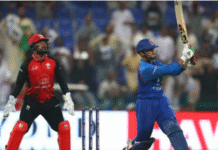
Bangladesh today reached a grand milestone. The whole country today celebrates 50 years of its independence — our very own golden jubilee. And there could be no better time to glance back at the starting point and see how far we have come during this time span.
The country’s sports arena, like in all the other sectors, has touched high points, made history and achieved glory while also producing some bleak moments and low points in these 50 years. While taking a look back at contributions of the country’s sportsmen in the liberation, we need to acknowledge all the young athletes, from different disciplines, who stepped up and joined the masses and actively participated in the liberation war, with many athletes even sacrificing their lives for the greater cause.
The most discussed and well recognized of all is the involvement of former cricketer Shaheed Jewel and Shaheed Mushtaque in the liberation war. To point out singularly, Mushtaque was one of the victims of the brutal genocide that took place on this very night fifty years ago. On the blood-splattered night of March 25, 1971, Mushtaque was shot dead by the Pakistan army near his beloved Azad Boys Club which was then situated in Dhaka’s Gulistan.
Meanwhile, Shaheed Jewel, who was an attacking right-handed opening batsman for Azad Boys Club, was one of the first active cricketers of erstwhile East Pakistan to take up arms and join the fight for freedom. After a heroic nine months on the battlefield, he was captured by the Pakistan army towards the end of the War and was killed just days before Bangladesh became independent.
There are innumerable athletes like Jewel and Mushtaque from different disciplines who turned into freedom fighters during the Liberation War. Since then, the contributions of all the martyrs is now remembered with the utmost respect by having different stands and stadiums named after them or even through organising different tournaments in their memory.
A minute body, namely the East Pakistan Sports Federation, which was under the education ministry of Pakistan, was in charge of regulating the small-scale sporting activities that took place back then. All that was needed back then was just one almirah for each of the handful of sporting disciplines to help them run. To put it simply, the country’s cricket was confined to one single wardrobe. And such was the case for all the other sports.
Achievements in sport and its expansion are two different things. And if we talk about structural expansions of sports in general, the improvements and developments since liberation have been nothing short of exemplary. From breaking free from the confinement of small wardrobes to now each discipline functioning independently under separate and designated sports federations — the structural expansion of sports over the years since independence has reached new heights.
But when we have to mention the other facet of sports — the achievements — there should be no denying that it is cricket out of all the other disciplines that has flourished the most since independence.
Cricket started from zero. From initially being just an associate member of the ICC to targeting full membership, from eventually being handed One Day and Test status to keep thriving and registering remarkable wins and achievements — Bangladesh have emerged as an elite cricket force after having started from nowhere in the cricketing world initially. Although there is a long way to go in T20s and Tests, the Tigers have surely garnered respect through their achievements in the ODI format over the years.
It is cricket that has given the country its brightest star in the form of Shakib Al Hasan, who remains the greatest achievement of the whole sports fraternity of the country.
The fact that young sports enthusiasts of the country now do not hesitate to take up and consider cricket as a respectable profession like that of an engineer or doctor is also proof of the major strides made by cricket during such a short time span.
Then again, on the flip side, football, a sport that was the most popular in the 70s to early 90s, has now lost its charm. Bangladesh used to be considered a strong force among the SAFF-playing nations. It is true that despite prevailing as one of the most beloved games in the country till date, the quality of football has taken a huge nosedive in the past years. Organisational failure coupled with eternal lust for power by the ones at the helm are equally to be blamed for such a dire plight of the game.
There has also been a huge cultural change in the overall sports. It was the passionate urge of sports enthusiasts and former sportsmen that used to push them to work at the grassroots level of their respectable sporting fields.
But, with the introduction of the commercial aspect in the sporting arena, cash-rich patrons, who have zero understanding and interest in development of sports, are now controlling every nook and cranny of sports. As such, many sports like football, hockey and even athletics, that were considered to have a bright future, have now ultimately lost their old charm.
Nevertheless, there have been notable improvements in the sporting arena as many new sports in the country have emerged. Golf, a sport that once used to be only considered for an elite group of people, has thrived after independence.
It is also a gradual development of sporting culture and broadening of the mass mentality that champion women athletes — like cricketers Salma Khatun and Jahanara Alam, swimmer Mahfuza Khatun Shila, weightlifter Mabia Akter Shimanta, archer Ety Khatun, chess player Rani Hamid and table tennis player Zobera Rahman — are being able to break and rise above stereotypical barriers to leave their mark in the sporting arena and keep inspiring up-and-coming prospects.
The wave of development has also touched sports journalism. There was a time sports reporting was only done by part-timers as it needed no specific expertise. But the introduction of technology and consequent ever-increasing exposure to all kinds of sports around the globe has now made sports journalism a craft that needs to be mastered, not one that can be done by mere part-timers anymore.
There was a time when sports hardly got any good place in newspapers and if there was a need to sacrifice any page on a given day, without hesitation the easy victim was the sports page. Now we cannot think like that.
What did we actually get? We went from a small canvas to a big canvas. One where we can draw anything with full freedom.
Jalal Ahmed Chowdhury: Well-known cricket writer and coach.









